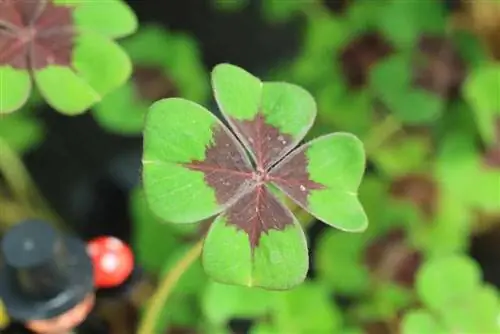- Author admin [email protected].
- Public 2023-12-17 03:39.
- Last modified 2025-01-24 12:45.
Clover is usually three-leaved, as its botanical name 'Trifolium' suggests. Apart from the 'lucky clover' offered in stores, which is not real clover, the four-leaf mutations can only be found with a lot of patience and perseverance and are most likely to be found among white-flowering clover varieties. The belief in lucky charms and good luck symbols is still present today and the four-leaf clover is one of the most sought-after.
Four-leaf clover meaning
Even though four-leaf clovers are rare in nature, there is actually no good reason why they should bring good luck. Nevertheless, the Celts were apparently already searching for them with vigor. Finding one was relatively unlikely, or at least extremely difficult. Nevertheless, the four-leaf clover has hardly lost any of its symbolic power to this day.
In order to be able to fulfill its role as a lucky charm, it is important that you find it yourself and that the find was accidental. It must not be cultivated, such as the 'lucky clover' sold in stores, which is not real clover. The lucky four-leaf clover is not a special type of clover, but a mutation, of which there is said to be only one in a thousand. If you actually discover one, it's best to keep it or give it to a loved one as a sign of affection and good luck.
Original meaning
Each leaf of a clover has its own meaning. The four-leaf clover is a cosmic symbol and is said to connect the four cardinal points with the four elements of fire, water, air and earth. On the other hand, the first leaf stands for fame, the second for we alth, the third for a loyal lover and the fourth for good he alth. The origins of the shamrock as a lucky charm go back more than 2,200 years. This rarity was once only reserved for the so-called Druids (intellectual and cult elite in Celtic and mythology). In Celtic times, many plants were said to have magical powers, especially the four-leaf clover.

The Celts believed that nothing bad could happen to them if they were in possession of one of these clovers. A four-leaf clover was supposed to give them magical powers, protect them from evil spirits and avert evil spells from them. For example, it was sewn into the clothing of travelers in the Middle Ages to protect them from harm on their journey.
Meaning in Christianity
In the Christian religion, a three-leaf clover has always symbolized the Trinity, while the four-leaf clover represented both the cross and the four evangelists. It appears very often in biblical depictions. According to a legend, the biblical figure Eve took one of these clover leaves with her after the fall of man in order to be able to remember the lushness of the Garden of Eden or paradise. A four-leaf clover is said to bring particularly good luck if you take it with you to the Sunday service in the prayer book. If you don't specifically look for it and find it purely by chance, it is said to be able to fulfill wishes and bring love. These clovers have always been associated with love and marriage.
The lucky finder should be able to get married within just one day. When placed in the shoe, the next person you come across is supposed to be your future partner, depending on your preferred gender. And if you pick it before sunrise and put it in your shoe or put it in your prayer book, it is said to give the finder the ability to recognize witches or witchcraft and other evil beings.
Tip:
In addition to four-leaf clovers, there are also five or six-leaf clovers, which are at least as rare. While the five-leaf is said to bring bad luck, a six-leaf means we alth for the finder.
Symbol of luck and we alth
Even today, the four-leaf clover is for many a synonym for luck and we alth, the latter also in a spiritual sense in the form of friendship, satisfaction and balance. A dried four-leaf clover placed in a school book is said to result in better grades. If you put it under your pillow, it is said to give those who sleep on it beautiful dreams.

According to a traditional legend, a four-leaf clover once actually saved the life of an emigrant. He found the clover on a private property and was arrested while picking it. As a result, he didn't get to his ship in time and missed it. Later newspapers reported the sinking of this ship and that there were no survivors. Consequently, it brought the emigrant incredible luck and practically saved his life.
“Lucky clover” not real clover
Since a four-leaf clover is hardly or only difficult to find in nature, resourceful gardeners have made a virtue of necessity and now also offer the supposed lucky charm as a potted plant. However, this plant has nothing to do with the clover in the meadow other than its appearance. He is not a clover and is not related to him. The plants offered in stores are primarily the four-leaf wood sorrel 'Oxalis tetraphylla', which is native to Mexico.
Tip:
What many people don't know is that it is precisely this lucky clover that produces edible and very tasty turnips that can be harvested in late autumn.






